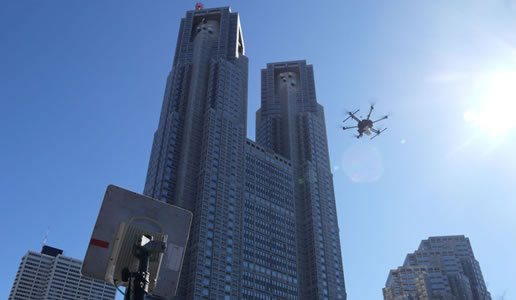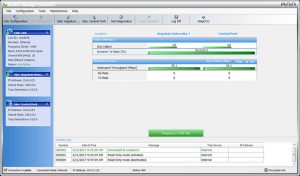News
Rikei Participates in a Disaster Response Test in the Skyscraper Area Utilizing Drones — Establishing a system that enables information gathering through inter-base communication using long-distance wireless communication —

Rikei Corporation (Head Office: Shinjuku-ku, Tokyo; President & CEO: Satoru Isaka; hereinafter “Rikei”) is pleased to announce that on Feb. 11, it participated in the disaster response test organized by Team Shinjuku (*1) , which consists of members of the Council for Measures to Reduce Disaster Risks in the Shinjuku Station Area, in the skyscraper area using drones.
In this test, carried out in the Shinjuku West Exit and Shinjuku Station areas, one of Japan’s most prominent densely populated areas that have many skyscrapers, the members of the Team Shinjuku confirmed the effectiveness of using unmanned small aircrafts (drones) and issues to be addressed in the future in order to find how to gather information and guide stranded people under disaster conditions.
*1 Team Shinjuku consists of members of the Council for Measures to Reduce Disaster Risks in the Shinjuku Station Area: Sompo Japan Nipponkoa Insurance Inc., Sompo Risk Management & Health Care Inc., Kogakuin University, Rikei Corporation, and Shinjuku City.
Overview of the system
When a disaster occurs, it is important to ensure cooperation between the headquarters set up at the site of the disaster and its bases. In this test, Team Shinjuku used drones to ascertain the situation of each area and established a system that enabled information sharing among the bases using long-distance wireless communication. If a disaster occurs, this will allow Team Shinjuku to ensure that visual information can be shared among the location from which the drone takes off and lands, the local headquarters and its bases and that stranded people can be guided using speakers mounted on drones.
As part of the infrastructure needed to gather information, Rikei provided and installed a long-distance wireless LAN system in cooporation with its partner company Nitto Telecommunications. Therefore, it built a 100 Mbps wireless communication infrastructure between the local headquarters and its bases.
Team Shinjuku used this infrastructure to multicast drone images to the bases through IBEX Technology’s encoder/decoder (ultra-low latency H.264 codec) as well as to stream videos from network cameras to confirm the situation of the bases.

▲Throughput confirmation screen using wireless utilities
Advantages of RAD Data Communications’ long-distance wireless antenna Airmux Series
- 4.9 GHz FWA (fixed wireless access) supporting carrier grade 1:1 and 1:N communications which enables long-distance, high-speed transmission
- OFDM (*2) modulation and 2×2 MIMO (*3) technology, which boasts of its total capacity up to 250 Mbps, provides excellent bandwidth guarantee.
- Enables diversity configurations (*4) , which are suitable for overseas propagation to remote islands
- Provides a full array of mobility products for mobile terminals, enabling a combination of abundant ODUs and antennas that fits the applications used
*2 Orthogonal frequency division multiplexing (OFDM) is one of the digital signal modulation methods that multiplex many orthogonal carrier signals.
*3 Multiple input multiple output (MIMO) is one of the high-speed wireless communication technologies in which the base station and the terminal use two antennas to exchange different data simultaneously. It practically produces the effect of widening the bandwidth that can be used.
*4 Diversity configuration is a configuration method to improve the quality of communication by giving priority to using those of the same wireless signals received via several antennas, which are excellent as radio waves, or excluding noise through synthesis of the signals received.
Future Plans
In 2003, Rikei proposed J-Alert, a system for the national government to communicate emergency information to people instantaneously, to the Fire and Disaster Management Agency of the Ministry of Internal Affairs and Communications. Going forward, Rikei will continue taking part in disaster response tests making the most of the results it has brought by working on disaster risk reduction (DRR) systems. Furthermore, it will propose and build useful and practical disaster information systems for local governments, thus contributing further to society in the DRR area.
[About Rikei Corporation]
Established in 1957, Rikei Corporation is a solution provider for the IT and electronics industries.
Rikei offers a wide variety of solutions centered on the world’s cutting edge technologies and advanced products in the fields of system solutions, such as entrance exam and educational affairs systems and IT infrastructure, business strategy, and information security solutions. It also provides network solutions, such as satellite communication data transfer systems, digital video transfer systems, network systems for telecommunication operators and other private companies, wireless access systems, and disaster management information systems. In addition to solutions, Rikei provides electronic components and devices, such as high frequency components, high performance adhesives for industrial use, testers for automotive audio and navigation equipment, power grid analysis systems, defense-related machinery and security systems.
| Headquarters Address: | Shinjuku Nomura Building, 1-26-2 Nishi-Shinjuku, Shinjuku-ku, Tokyo 163-0535, Japan |
|---|---|
| Capital: | ¥3,427 million (as of the end of March, 2016) |
| President & CEO: | Satoru Isaka |
| Field of Business: |
Sales of the following;
|
| Corporate URL: | https://www.rikei.co.jp/en/ |
Product names and company names mentioned herein are trademarks or registered trademarks of their respective companies.
Contact
System Sales Group, Disaster Prevention Information System Sales Dept.
Tel:+81-03-3345-2178(dial-in)
E-mail:j-alert@rikei.co.jp
